 源码剖析-Run方法执行流程
源码剖析-Run方法执行流程
SpringBoot项目的mian函数
@SpringBootApplication //来标注一个主程序类,说明这是一个Spring Boot应用
public class MyTestMVCApplication {
public static void main(String[] args) {
SpringApplication.run(MyTestMVCApplication.class, args);
}
}
2
3
4
5
6
7
8
点进run方法
public static ConfigurableApplicationContext run(Class<?> primarySource, String... args) {
// 调用重载方法
return run(new Class<?>[] { primarySource }, args);
}
public static ConfigurableApplicationContext run(Class<?>[] primarySources, String[] args) {
// 两件事:1.初始化SpringApplication 2.执行run方法
return new SpringApplication(primarySources).run(args);
}
2
3
4
5
6
7
8
9
10
11
12
13
14
# SpringApplication() 构造方法
继续查看源码, SpringApplication 实例化过程,首先是进入带参数的构造方法,最终回来到两个参数的构造方法。
public SpringApplication(Class<?>... primarySources) {
this(null, primarySources);
}
@SuppressWarnings({"unchecked", "rawtypes"})
public SpringApplication(ResourceLoader resourceLoader, Class<?>... primarySources) {
//设置资源加载器为null
this.resourceLoader = resourceLoader;
//断言加载资源类不能为null
Assert.notNull(primarySources, "PrimarySources must not be null");
//将primarySources数组转换为List,最后放到LinkedHashSet集合中
this.primarySources = new LinkedHashSet<>(Arrays.asList(primarySources));
//【1.1 推断应用类型,后面会根据类型初始化对应的环境。常用的一般都是servlet环境 】
this.webApplicationType = WebApplicationType.deduceFromClasspath();
//【1.2 初始化classpath下 META-INF/spring.factories中已配置的ApplicationContextInitializer 】
setInitializers((Collection) getSpringFactoriesInstances(ApplicationContextInitializer.class));
//【1.3 初始化classpath下所有已配置的 ApplicationListener 】
setListeners((Collection) getSpringFactoriesInstances(ApplicationListener.class));
//【1.4 根据调用栈,推断出 main 方法的类名 】
this.mainApplicationClass = deduceMainApplicationClass();
}
2
3
4
5
6
7
8
9
10
11
12
13
14
15
16
17
18
19
20
21
22
23
24
25
26
27
28
29
30
31
32
33
34
# deduceWebApplicationType();
//常量值
private static final String[] WEB_ENVIRONMENT_CLASSES = {"javax.servlet.Servlet",
"org.springframework.web.context.ConfigurableWebApplicationContext"};
private static final String REACTIVE_WEB_ENVIRONMENT_CLASS = "org.springframework."
+ "web.reactive.DispatcherHandler";
private static final String MVC_WEB_ENVIRONMENT_CLASS = "org.springframework."
+ "web.servlet.DispatcherServlet";
private static final String JERSEY_WEB_ENVIRONMENT_CLASS = "org.glassfish.jersey.server.ResourceConfig";
/**
* 判断 应用的类型
* NONE: 应用程序不是web应用,也不应该用web服务器去启动
* SERVLET: 应用程序应作为基于servlet的web应用程序运行,并应启动嵌入式servlet web(tomcat)服务器。
* REACTIVE: 应用程序应作为 reactive web应用程序运行,并应启动嵌入式 reactive web服务器。
* @return
*/
private WebApplicationType deduceWebApplicationType() {
//classpath下必须存在org.springframework.web.reactive.DispatcherHandler
if (ClassUtils.isPresent(REACTIVE_WEB_ENVIRONMENT_CLASS, null)
&& !ClassUtils.isPresent(MVC_WEB_ENVIRONMENT_CLASS, null)
&& !ClassUtils.isPresent(JERSEY_WEB_ENVIRONMENT_CLASS, null)) {
return WebApplicationType.REACTIVE;
}
for (String className : WEB_ENVIRONMENT_CLASSES) {
if (!ClassUtils.isPresent(className, null)) {
return WebApplicationType.NONE;
}
}
//classpath环境下存在javax.servlet.Servlet或者org.springframework.web.context.ConfigurableWebApplicationContext
return WebApplicationType.SERVLET;
}
2
3
4
5
6
7
8
9
10
11
12
13
14
15
16
17
18
19
20
21
22
23
24
25
26
27
28
29
30
31
32
33
34
35
36
37
38
返回类型是WebApplicationType的枚举类型, WebApplicationType 有三个枚举,三个枚举的解释如其中注释
具体的判断逻辑如下:
WebApplicationType.REACTIVE classpath下存在org.springframework.web.reactive.DispatcherHandler WebApplicationType.SERVLET classpath下存在javax.servlet.Servlet或者org.springframework.web.context.ConfigurableWebApplicationContext WebApplicationType.NONE 不满足以上条件。
# setInitializers((Collection) getSpringFactoriesInstances(ApplicationContextInitializer.class));
初始化classpath下 META-INF/spring.factories中已配置的ApplicationContextInitializer
private <T> Collection<T> getSpringFactoriesInstances(Class<T> type) {
return getSpringFactoriesInstances(type, new Class<?>[]{});
}
/**
* 通过指定的classloader 从META-INF/spring.factories获取指定的Spring的工厂实例
* @param type
* @param parameterTypes
* @param args
* @param <T>
* @return
*/
private <T> Collection<T> getSpringFactoriesInstances(Class<T> type,
Class<?>[] parameterTypes, Object... args) {
ClassLoader classLoader = Thread.currentThread().getContextClassLoader();
// Use names and ensure unique to protect against duplicates
//通过指定的classLoader从 META-INF/spring.factories 的资源文件中,
//读取 key 为 type.getName() 的 value
Set<String> names = new LinkedHashSet<>(SpringFactoriesLoader.loadFactoryNames(type, classLoader));
//创建Spring工厂实例
List<T> instances = createSpringFactoriesInstances(type, parameterTypes,
classLoader, args, names);
//对Spring工厂实例排序(org.springframework.core.annotation.Order注解指定的顺序)
AnnotationAwareOrderComparator.sort(instances);
return instances;
}
2
3
4
5
6
7
8
9
10
11
12
13
14
15
16
17
18
19
20
21
22
23
24
25
26
27
看看 getSpringFactoriesInstances 都干了什么,看源码,有一个方法很重要 loadFactoryNames() 这个方法很重要,这个方法是spring-core中提供的从META-INF/spring.factories中获取指定的类(key)的同一入口方法。
在这里,获取的是key为 org.springframework.context.ApplicationContextInitializer 的类。
debug看看都获取到了哪些
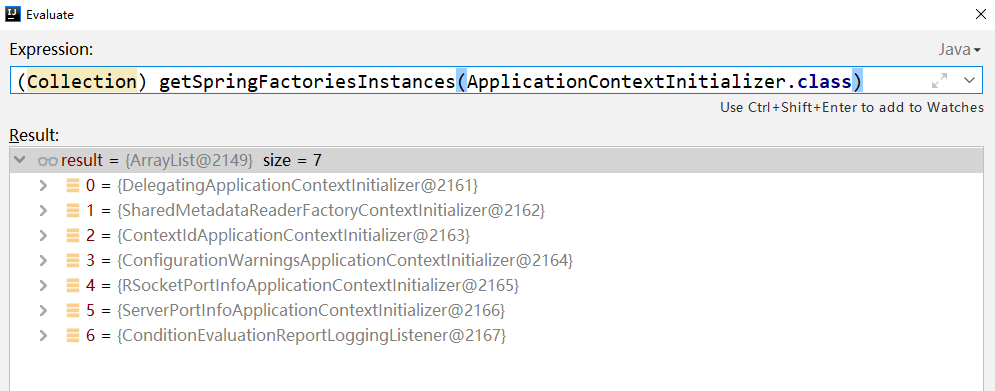
上面说了,是从classpath下 META-INF/spring.factories中获取,我们验证一下:


发现在上图所示的两个工程中找到了debug中看到的结果。
ApplicationContextInitializer 是Spring框架的类, 这个类的主要目的就是在 ConfigurableApplicationContext 调用refresh()方法之前,回调这个类的initialize方法。
通过 ConfigurableApplicationContext 的实例获取容器的环境Environment,从而实现对配置文件的修改完善等工作。
# setListeners((Collection) getSpringFactoriesInstances(ApplicationListener.class));
初始化classpath下 META-INF/spring.factories中已配置的 ApplicationListener。
ApplicationListener 的加载过程和上面的 ApplicationContextInitializer 类的加载过程是一样的。不多说了,至于 ApplicationListener 是spring的事件监听器,典型的观察者模式,通过 ApplicationEvent 类和 ApplicationListener 接口,可以实现对spring容器全生命周期的监听,当然也可以自定义监听事件
# 总结
关于 SpringApplication 类的构造过程,到这里我们就梳理完了。纵观 SpringApplication 类的实例化过程,我们可以看到,合理的利用该类,我们能在spring容器创建之前做一些预备工作,和定制化的需求。
比如,自定义SpringBoot的Banner,比如自定义事件监听器,再比如在容器refresh之前通过自定义 ApplicationContextInitializer 修改配置一些配置或者获取指定的bean都是可以的
# run(args)
上一小节我们查看了SpringApplication 类的实例化过程,这一小节总结SpringBoot启动流程最重要的部分run方法。通过run方法梳理出SpringBoot启动的流程,
经过深入分析后,大家会发现SpringBoot也就是给Spring包了一层皮,事先替我们准备好Spring所需要的环境及一些基础
/**
* Run the Spring application, creating and refreshing a new
* {@link ApplicationContext}.
*
* @param args the application arguments (usually passed from a Java main method)
* @return a running {@link ApplicationContext}
*
* 运行spring应用,并刷新一个新的 ApplicationContext(Spring的上下文)
* ConfigurableApplicationContext 是 ApplicationContext 接口的子接口。在 ApplicationContext
* 基础上增加了配置上下文的工具。 ConfigurableApplicationContext是容器的高级接口
*/
public ConfigurableApplicationContext run(String... args) {
//记录程序运行时间
StopWatch stopWatch = new StopWatch();
stopWatch.start();
// ConfigurableApplicationContext Spring 的上下文
ConfigurableApplicationContext context = null;
Collection<SpringBootExceptionReporter> exceptionReporters = new ArrayList<>();
configureHeadlessProperty();
//从META-INF/spring.factories中获取监听器
//1、获取并启动监听器
SpringApplicationRunListeners listeners = getRunListeners(args);
listeners.starting();
try {
ApplicationArguments applicationArguments = new DefaultApplicationArguments(
args);
//2、构造应用上下文环境
ConfigurableEnvironment environment = prepareEnvironment(listeners, applicationArguments);
//处理需要忽略的Bean
configureIgnoreBeanInfo(environment);
//打印banner
Banner printedBanner = printBanner(environment);
///3、初始化应用上下文
context = createApplicationContext();
//实例化SpringBootExceptionReporter.class,用来支持报告关于启动的错误
exceptionReporters = getSpringFactoriesInstances(
SpringBootExceptionReporter.class,
new Class[]{ConfigurableApplicationContext.class}, context);
//4、刷新应用上下文前的准备阶段
prepareContext(context, environment, listeners, applicationArguments, printedBanner);
//5、刷新应用上下文
refreshContext(context);
//刷新应用上下文后的扩展接口
afterRefresh(context, applicationArguments);
//时间记录停止
stopWatch.stop();
if (this.logStartupInfo) {
new StartupInfoLogger(this.mainApplicationClass)
.logStarted(getApplicationLog(), stopWatch);
}
//发布容器启动完成事件
listeners.started(context);
callRunners(context, applicationArguments);
} catch (Throwable ex) {
handleRunFailure(context, ex, exceptionReporters, listeners);
throw new IllegalStateException(ex);
}
try {
listeners.running(context);
} catch (Throwable ex) {
handleRunFailure(context, ex, exceptionReporters, null);
throw new IllegalStateException(ex);
}
return context;
}
2
3
4
5
6
7
8
9
10
11
12
13
14
15
16
17
18
19
20
21
22
23
24
25
26
27
28
29
30
31
32
33
34
35
36
37
38
39
40
41
42
43
44
45
46
47
48
49
50
51
52
53
54
55
56
57
58
59
60
61
62
63
64
65
66
67
在以上的代码中,启动过程中的重要步骤共分为六步
第一步:获取并启动监听器
第二步:构造应用上下文环境
第三步:初始化应用上下文
第四步:刷新应用上下文前的准备阶段
第五步:刷新应用上下文
第六步:刷新应用上下文后的扩展接口
2
3
4
5
6
OK,下面SpringBoot的启动流程分析,我们就根据这6大步骤进行详细解读。最总要的是第四,五步。我们会着重的分析。
# 第一步:获取并启动监听器
事件机制在Spring是很重要的一部分内容,通过事件机制我们可以监听Spring容器中正在发生的一些事件,同样也可以自定义监听事件。Spring的事件为Bean和Bean之间的消息传递提供支持。当一个对象处理完某种任务后,通知另外的对象进行某些处理,常用的场景有进行某些操作后发送通知,消息、邮件等情况。
private SpringApplicationRunListeners getRunListeners(String[] args) {
Class<?>[] types = new Class<?>[]{SpringApplication.class, String[].class};
return new SpringApplicationRunListeners(logger, getSpringFactoriesInstances(
SpringApplicationRunListener.class, types, this, args));
}
2
3
4
5
在这里面是不是看到一个熟悉的方法:getSpringFactoriesInstances(),可以看下面的注释,前面的小节我们已经详细介绍过该方法是怎么一步步的获取到META-INF/spring.factories中的指定的key的value,获取到以后怎么实例化类的。
/**
* 通过指定的classloader 从META-INF/spring.factories获取指定的Spring的工厂实例
* @param type
* @param parameterTypes
* @param args
* @param <T>
* @return
*/
private <T> Collection<T> getSpringFactoriesInstances(Class<T> type,
Class<?>[] parameterTypes, Object... args) {
ClassLoader classLoader = Thread.currentThread().getContextClassLoader();
// Use names and ensure unique to protect against duplicates
//通过指定的classLoader从 META-INF/spring.factories 的资源文件中,
//读取 key 为 type.getName() 的 value
Set<String> names = new LinkedHashSet<>(SpringFactoriesLoader.loadFactoryNames(type, classLoader));
//创建Spring工厂实例
List<T> instances = createSpringFactoriesInstances(type, parameterTypes,
classLoader, args, names);
//对Spring工厂实例排序(org.springframework.core.annotation.Order注解指定的顺序)
AnnotationAwareOrderComparator.sort(instances);
return instances;
}
2
3
4
5
6
7
8
9
10
11
12
13
14
15
16
17
18
19
20
21
22
回到run方法,debug这个代码 SpringApplicationRunListeners listeners = getRunListeners(args); 看一下获取的是哪个监听器:

EventPublishingRunListener监听器是Spring容器的启动监听器。
listeners.starting(); 开启了监听事件。
# 第二步:构造应用上下文环境
应用上下文环境包括什么呢?包括计算机的环境,Java环境,Spring的运行环境,Spring项目的配置(在SpringBoot中就是那个熟悉的application.properties/yml)等等。
首先看一下prepareEnvironment()方法。
private ConfigurableEnvironment prepareEnvironment(
SpringApplicationRunListeners listeners,
ApplicationArguments applicationArguments) {
// Create and configure the environment
//创建并配置相应的环境
ConfigurableEnvironment environment = getOrCreateEnvironment();
//根据用户配置,配置 environment系统环境
configureEnvironment(environment, applicationArguments.getSourceArgs());
// 启动相应的监听器,其中一个重要的监听器 ConfigFileApplicationListener 就是加载项目配置文件的监听器。
listeners.environmentPrepared(environment);
bindToSpringApplication(environment);
if (this.webApplicationType == WebApplicationType.NONE) {
environment = new EnvironmentConverter(getClassLoader())
.convertToStandardEnvironmentIfNecessary(environment);
}
ConfigurationPropertySources.attach(environment);
return environment;
}
2
3
4
5
6
7
8
9
10
11
12
13
14
15
16
17
18
看上面的注释,方法中主要完成的工作,首先是创建并按照相应的应用类型配置相应的环境,然后根据用户的配置,配置系统环境,然后启动监听器,并加载系统配置文件。
# ConfigurableEnvironment environment = getOrCreateEnvironment();
看看getOrCreateEnvironment()干了些什么。
private ConfigurableEnvironment getOrCreateEnvironment() {
if (this.environment != null) {
return this.environment;
}
//如果应用类型是 SERVLET 则实例化 StandardServletEnvironment
if (this.webApplicationType == WebApplicationType.SERVLET) {
return new StandardServletEnvironment();
}
return new StandardEnvironment();
}
2
3
4
5
6
7
8
9
10
通过代码可以看到根据不同的应用类型初始化不同的系统环境实例。前面咱们已经说过应用类型是怎么判断的了,这里就不在赘述了
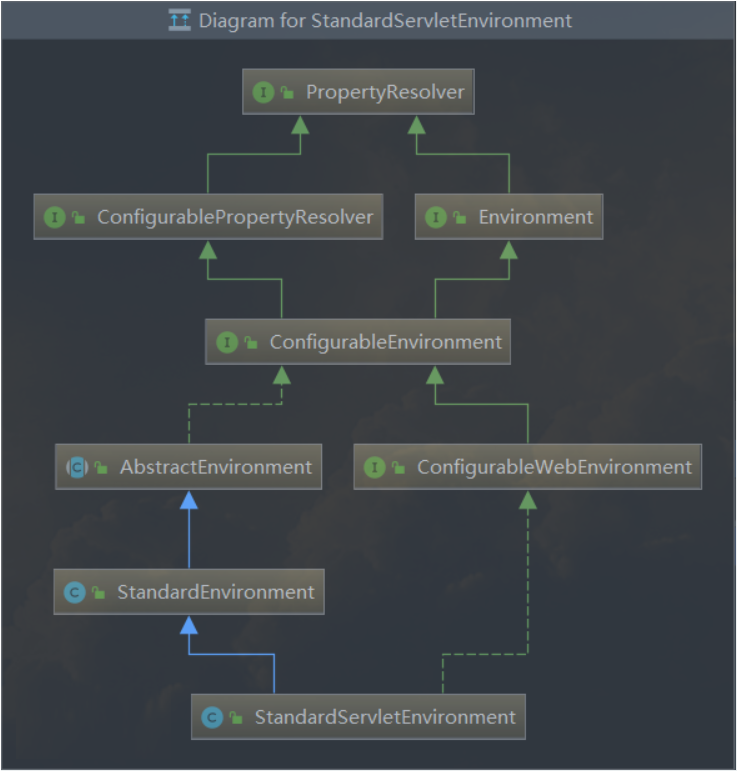
从上面的继承关系可以看出,StandardServletEnvironment是StandardEnvironment的子类。这两个对象也没什么好讲的,当是web项目的时候,环境上会多一些关于web环境的配置。
# configureEnvironment(environment, applicationArguments.getSourceArgs());
protected void configureEnvironment(ConfigurableEnvironment environment,
String[] args) {
// 将main 函数的args封装成 SimpleCommandLinePropertySource 加入环境中。
configurePropertySources(environment, args);
// 激活相应的配置文件
configureProfiles(environment, args);
}
2
3
4
5
6
7
在执行完方法中的两行代码后,debug的截图如下
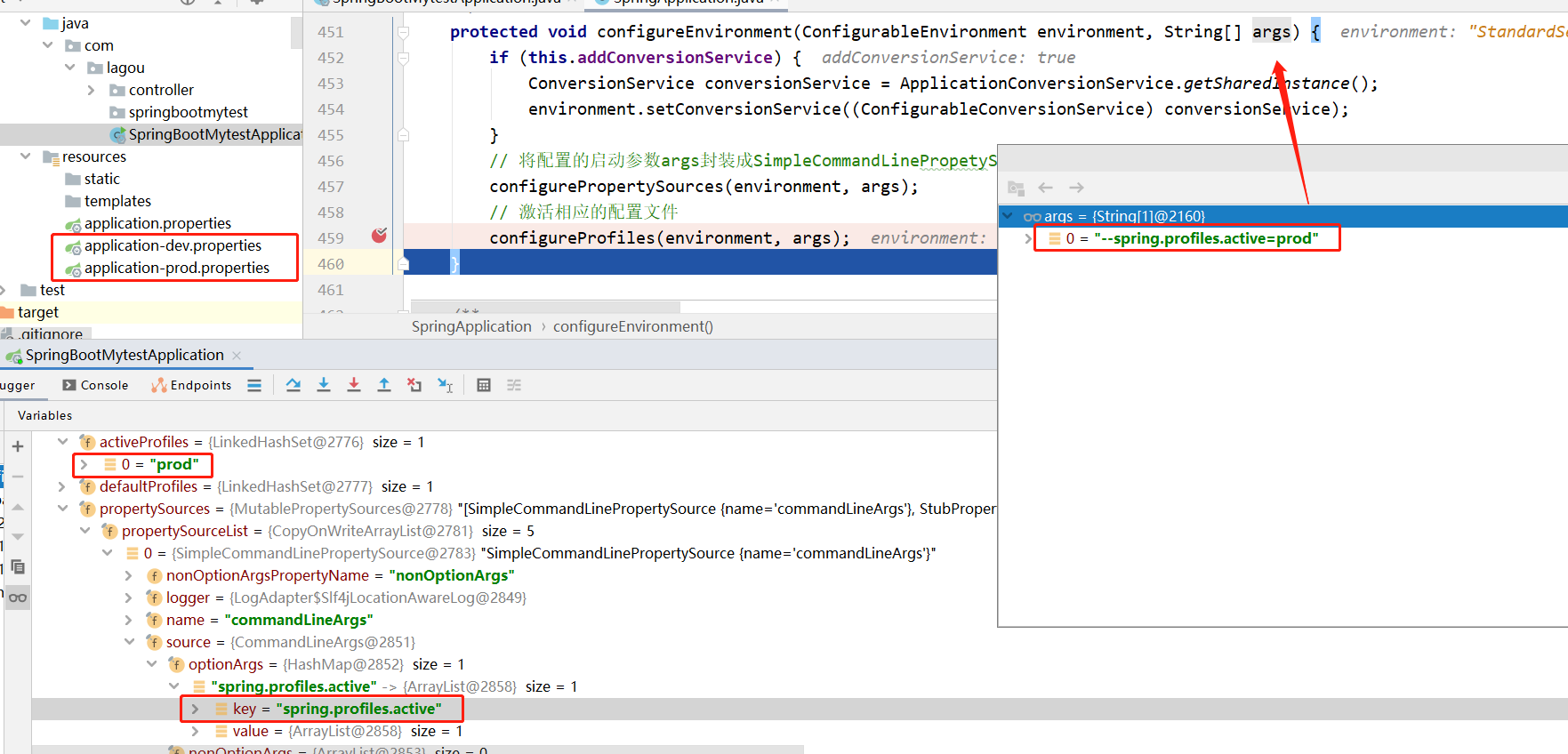
如下图所示,我在spring的启动参数中指定了参数:--spring.profiles.active=prod
(就是启动多个实例用的)
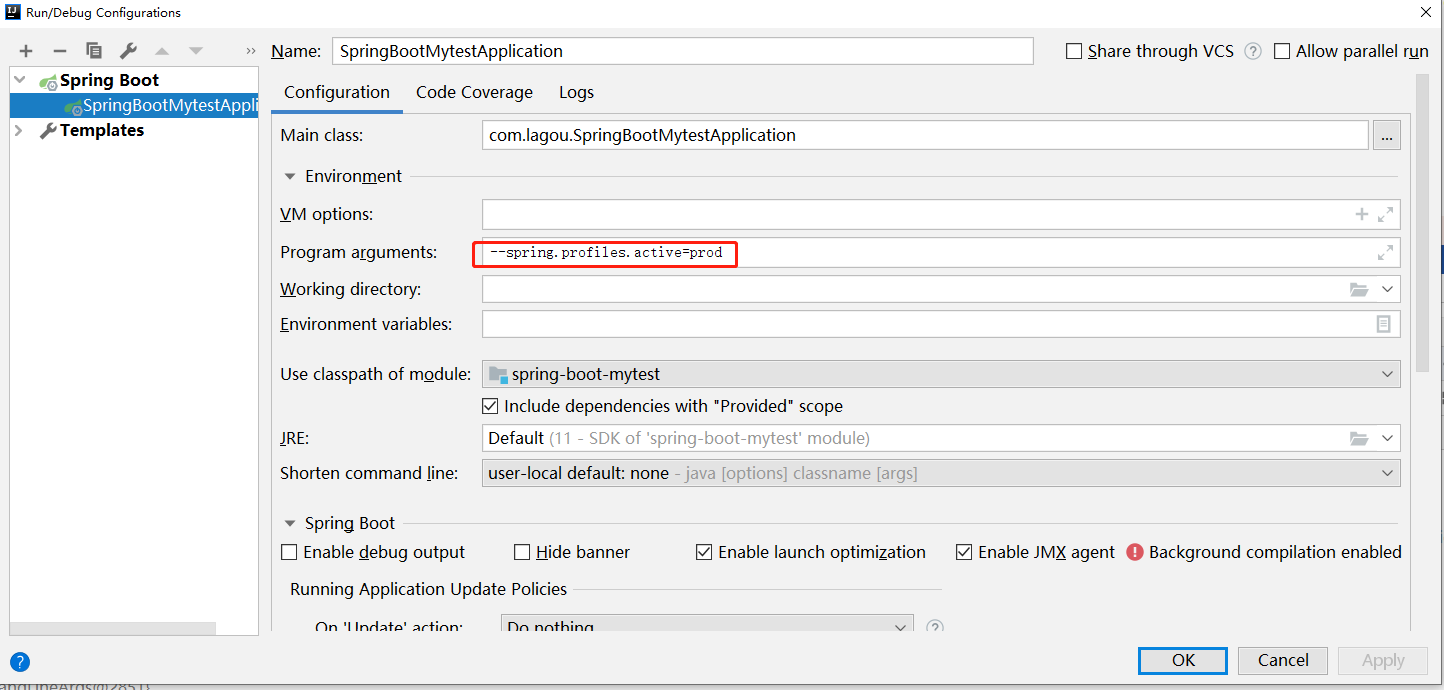
在configurePropertySources(environment, args);中将args封装成了SimpleCommandLinePropertySource并加入到了environment中。
configureProfiles(environment, args);根据启动参数激活了相应的配置文件。
# listeners.environmentPrepared(environment);
进入到方法一路跟下去就到了SimpleApplicationEventMulticaster类的multicastEvent()方法。
-SimpleApplicationEventMulticaster
public void multicastEvent(ApplicationEvent event) {
multicastEvent(event, resolveDefaultEventType(event));
}
2
3
4
5
6
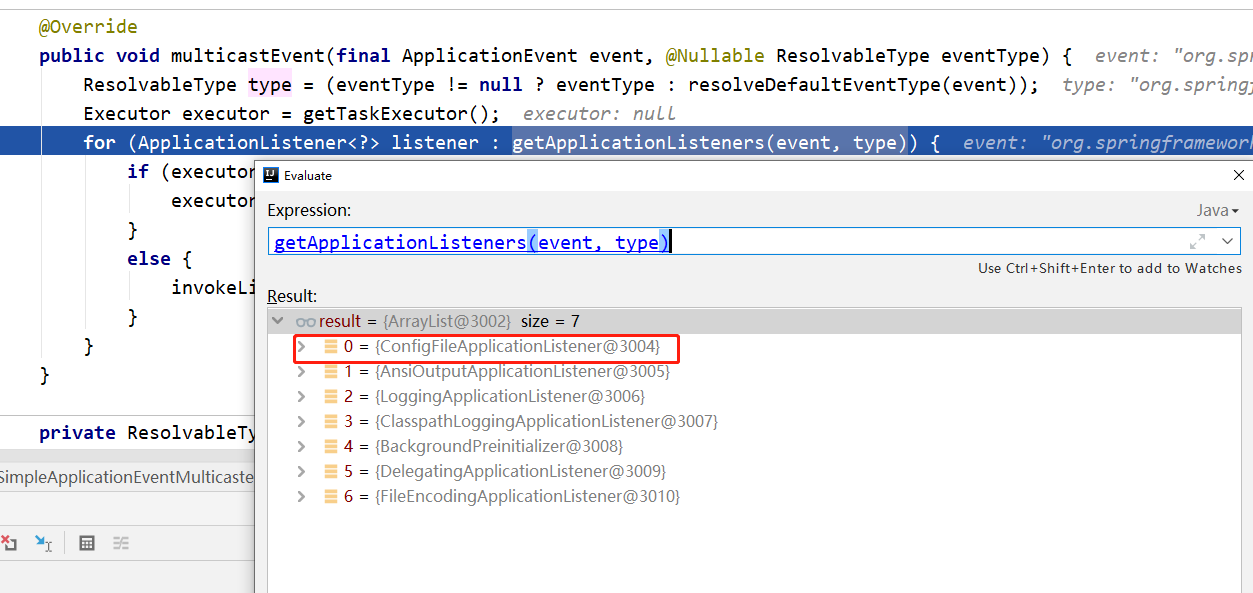
查看getApplicationListeners(event, type)执行结果,发现一个重要的监听器ConfigFileApplicationListener。
先看看这个类的注释
* {@link EnvironmentPostProcessor} that configures the context environment by loading
* properties from well known file locations. By default properties will be loaded from
* 'application.properties' and/or 'application.yml' files in the following locations:
* <ul>
* <li>file:./config/</li>
* <li>file:./</li>
* <li>classpath:config/</li>
* <li>classpath:</li>
* </ul>
* The list is ordered by precedence (properties defined in locations higher in the list
* override those defined in lower locations).
* <p>
* Alternative search locations and names can be specified using
* {@link #setSearchLocations(String)} and {@link #setSearchNames(String)}.
* <p>
* Additional files will also be loaded based on active profiles. For example if a 'web'
* profile is active 'application-web.properties' and 'application-web.yml' will be
* considered.
* <p>
* The 'spring.config.name' property can be used to specify an alternative name to load
* and the 'spring.config.location' property can be used to specify alternative search
* locations or specific files.
* <p>
* 从默认的位置加载配置文件,将其加入上下文的environment变量中
2
3
4
5
6
7
8
9
10
11
12
13
14
15
16
17
18
19
20
21
22
23
24
这个监听器默认的从注释中
标签所示的几个位置加载配置文件,并将其加入 上下文的 environment变量中。当然也可以通过配置指定。
debug跳过 listeners.environmentPrepared(environment); 这一行,查看environment属性,果真如上面所说的,配置文件的配置信息已经添加上来了。
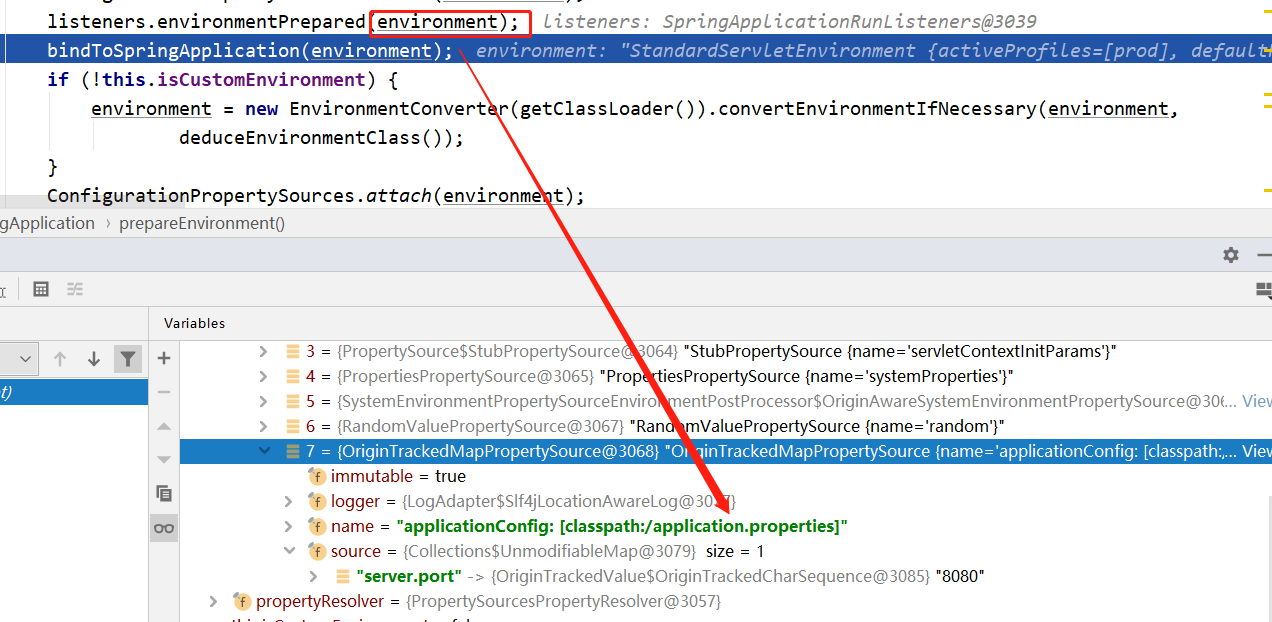
# 第三步:初始化应用上下文
在SpringBoot工程中,应用类型分为三种,如下代码所示。
public enum WebApplicationType {
/**
* 应用程序不是web应用,也不应该用web服务器去启动
*/
NONE,
/**
* 应用程序应作为基于servlet的web应用程序运行,并应启动嵌入式servlet web(tomcat)服务器。
*/
SERVLET,
/**
* 应用程序应作为 reactive web应用程序运行,并应启动嵌入式 reactive web服务器。
*/
REACTIVE
}
2
3
4
5
6
7
8
9
10
11
12
13
14
对应三种应用类型,SpringBoot项目有三种对应的应用上下文,我们以web工程为例,即其上下文为AnnotationConfigServletWebServerApplicationContext。
public static final String DEFAULT_WEB_CONTEXT_CLASS = "org.springframework.boot."
+ "web.servlet.context.AnnotationConfigServletWebServerApplicationContext";
public static final String DEFAULT_REACTIVE_WEB_CONTEXT_CLASS = "org.springframework."
+ "boot.web.reactive.context.AnnotationConfigReactiveWebServerApplicationContext";
public static final String DEFAULT_CONTEXT_CLASS = "org.springframework.context."
+ "annotation.AnnotationConfigApplicationContext";
protected ConfigurableApplicationContext createApplicationContext() {
Class<?> contextClass = this.applicationContextClass;
if (contextClass == null) {
try {
switch (this.webApplicationType) {
case SERVLET:
contextClass = Class.forName(DEFAULT_WEB_CONTEXT_CLASS);
break;
case REACTIVE:
contextClass = Class.forName(DEFAULT_REACTIVE_WEB_CONTEXT_CLASS);
break;
default:
contextClass = Class.forName(DEFAULT_CONTEXT_CLASS);
}
} catch (ClassNotFoundException ex) {
throw new IllegalStateException(
"Unable create a default ApplicationContext, "
+ "please specify an ApplicationContextClass",
ex);
}
}
return (ConfigurableApplicationContext) BeanUtils.instantiateClass(contextClass);
}
2
3
4
5
6
7
8
9
10
11
12
13
14
15
16
17
18
19
20
21
22
23
24
25
26
27
28
29
30
31
我们先看一下AnnotationConfigServletWebServerApplicationContext的设计
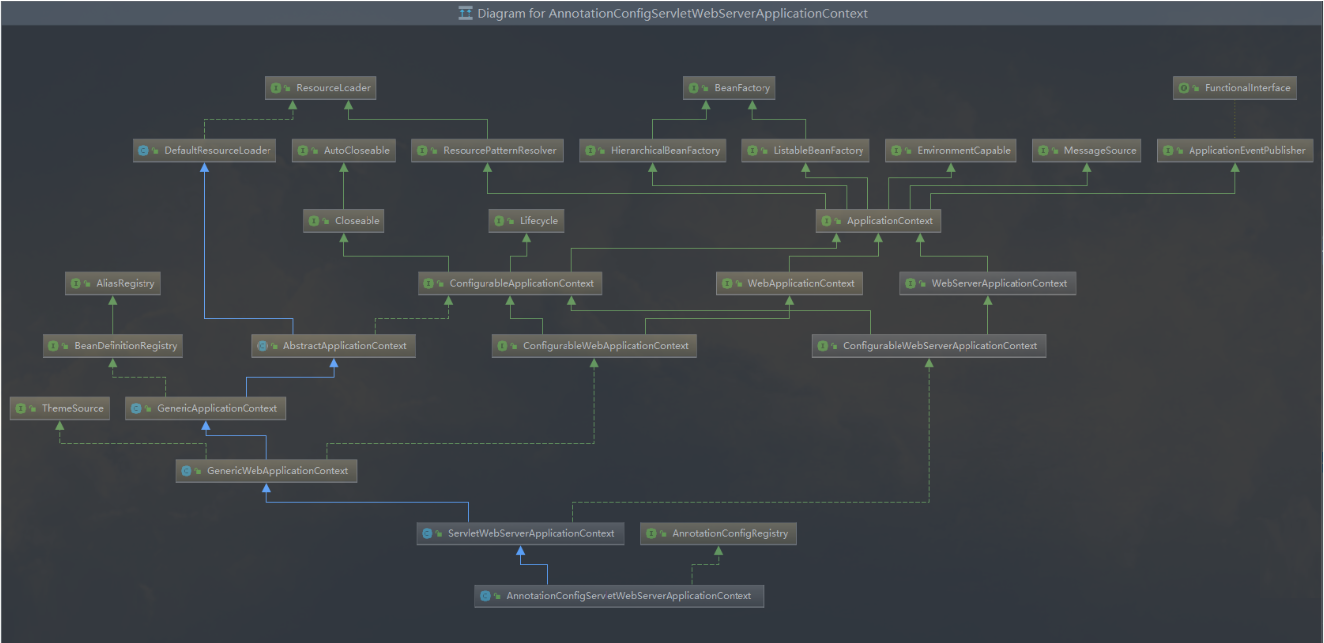
应用上下文可以理解成IoC容器的高级表现形式,应用上下文确实是在IoC容器的基础上丰富了一些高级功能。
应用上下文对IoC容器是持有的关系。他的一个属性beanFactory就是IoC容器(DefaultListableBeanFactory)。所以他们之间是持有,和扩展的关系。
接下来看GenericApplicationContext类
public class GenericApplicationContext extends AbstractApplicationContext implements BeanDefinitionRegistry {
private final DefaultListableBeanFactory beanFactory;
...
public GenericApplicationContext() {
this.beanFactory = new DefaultListableBeanFactory();
}
...
}
2
3
4
5
6
7
8
beanFactory正是在AnnotationConfigServletWebServerApplicationContext实现的接口GenericApplicationContext中定义的。在上面createApplicationContext()方法中的, BeanUtils.instantiateClass(contextClass) 这个方法中,不但初始化了AnnotationConfigServletWebServerApplicationContext类,也就是我们的上下文context,同样也触发了GenericApplicationContext类的构造函数,从而beanFactory(IOC容器)也创建了。
仔细看他的构造函数,有没有发现一个很熟悉的类DefaultListableBeanFactory,没错,DefaultListableBeanFactory就是IoC容器真实面目了。在后面的refresh()方法分析中,DefaultListableBeanFactory是无处不在的存在感。
debug跳过createApplicationContext()方法。
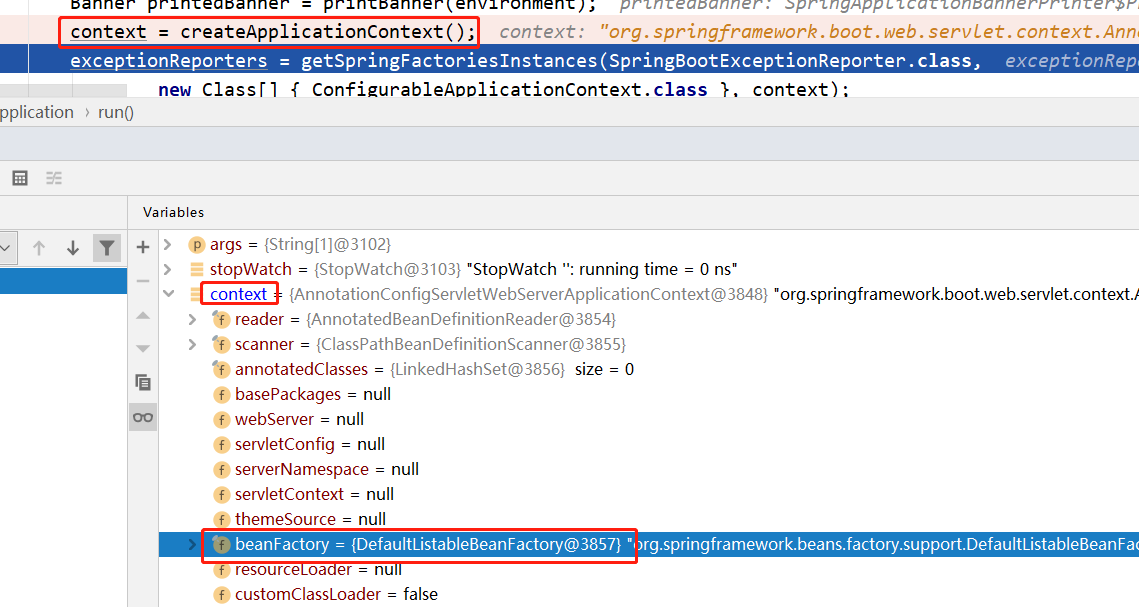
如上图所示,context就是我们熟悉的上下文(也有人称之为容器,都可以,看个人爱好和理解),beanFactory就是我们所说的IoC容器的真实面孔了。细细感受下上下文和容器的联系和区别,对于我们理解源码有很大的帮助。在我们学习过程中,我们也是将上下文和容器严格区分开来的。
# 第四步:刷新应用上下文前的准备阶段
# prepareContext()方法
前面我们介绍了SpringBoot 启动流程run()方法的前三步,接下来再来介绍:
第四步:刷新应用上下文前的准备阶段。也就是prepareContext()方法。
首先看prepareContext()方法。
private void prepareContext(ConfigurableApplicationContext context,
ConfigurableEnvironment environment, SpringApplicationRunListeners listeners,
ApplicationArguments applicationArguments, Banner printedBanner) {
//设置容器环境
context.setEnvironment(environment);
//执行容器后置处理
postProcessApplicationContext(context);
//执行容器中的 ApplicationContextInitializer 包括spring.factories和通过三种方式自定义的
applyInitializers(context);
//向各个监听器发送容器已经准备好的事件
listeners.contextPrepared(context);
if (this.logStartupInfo) {
logStartupInfo(context.getParent() == null);
logStartupProfileInfo(context);
}
// Add boot specific singleton beans
//将main函数中的args参数封装成单例Bean,注册进容器
context.getBeanFactory().registerSingleton("springApplicationArguments",
applicationArguments);
//将 printedBanner 也封装成单例,注册进容器
if (printedBanner != null) {
context.getBeanFactory().registerSingleton("springBootBanner", printedBanner);
}
// Load the sources
Set<Object> sources = getAllSources();
Assert.notEmpty(sources, "Sources must not be empty");
//加载我们的启动类,将启动类注入容器
load(context, sources.toArray(new Object[0]));
//发布容器已加载事件
listeners.contextLoaded(context);
}
2
3
4
5
6
7
8
9
10
11
12
13
14
15
16
17
18
19
20
21
22
23
24
25
26
27
28
29
30
31
32
33
34
35
首先看这行 Set sources = getAllSources(); 在getAllSources()中拿到了我们的启动类。 我们重点讲解这行 load(context, sources.toArray(new Object[0])); ,其他的方法请参阅注释。
跟进load()方法,看源码
protected void load(ApplicationContext context, Object[] sources) {
if (logger.isDebugEnabled()) {
logger.debug(
"Loading source " + StringUtils.arrayToCommaDelimitedString(sources));
}
//创建 BeanDefinitionLoader
BeanDefinitionLoader loader = createBeanDefinitionLoader(
getBeanDefinitionRegistry(context), sources);
if (this.beanNameGenerator != null) {
loader.setBeanNameGenerator(this.beanNameGenerator);
}
if (this.resourceLoader != null) {
loader.setResourceLoader(this.resourceLoader);
}
if (this.environment != null) {
loader.setEnvironment(this.environment);
}
loader.load();
}
2
3
4
5
6
7
8
9
10
11
12
13
14
15
16
17
18
19
# getBeanDefinitionRegistry()
继续看getBeanDefinitionRegistry()方法的源码
private BeanDefinitionRegistry getBeanDefinitionRegistry(ApplicationContext context) {
if (context instanceof BeanDefinitionRegistry) {
return (BeanDefinitionRegistry) context;
}
...
}
2
3
4
5
6
这里将我们前文创建的上下文强转为BeanDefinitionRegistry,他们之间是有继承关系的。BeanDefinitionRegistry定义了很重要的方法registerBeanDefinition(),该方法将BeanDefinition注册进DefaultListableBeanFactory容器的beanDefinitionMap中。
# createBeanDefinitionLoader()
继续看createBeanDefinitionLoader()方法,最终进入了BeanDefinitionLoader类的构造方法,如下
BeanDefinitionLoader(BeanDefinitionRegistry registry, Object... sources) {
Assert.notNull(registry, "Registry must not be null");
Assert.notEmpty(sources, "Sources must not be empty");
this.sources = sources;
//注解形式的Bean定义读取器 比如:@Configuration @Bean @Component @Controller @Service等等
this.annotatedReader = new AnnotatedBeanDefinitionReader(registry);
//XML形式的Bean定义读取器
this.xmlReader = new XmlBeanDefinitionReader(registry);
if (isGroovyPresent()) {
this.groovyReader = new GroovyBeanDefinitionReader(registry);
}
//类路径扫描器
this.scanner = new ClassPathBeanDefinitionScanner(registry);
//扫描器添加排除过滤器
this.scanner.addExcludeFilter(new ClassExcludeFilter(sources));
}
2
3
4
5
6
7
8
9
10
11
12
13
14
15
16
先记住上面的三个属性,上面三个属性在,BeanDefinition的Resource定位,和BeanDefinition的注册中起到了很重要的作用。
# loader.load();
跟进load()方法
private int load(Object source) {
Assert.notNull(source, "Source must not be null");
// 从Class加载
if (source instanceof Class<?>) {
return load((Class<?>) source);
}
// 从Resource加载
if (source instanceof Resource) {
return load((Resource) source);
}
// 从Package加载
if (source instanceof Package) {
return load((Package) source);
}
// 从 CharSequence 加载 ???
if (source instanceof CharSequence) {
return load((CharSequence) source);
}
throw new IllegalArgumentException("Invalid source type " + source.getClass());
}
2
3
4
5
6
7
8
9
10
11
12
13
14
15
16
17
18
19
20
当前我们的主类会按Class加载。
继续跟进load()方法。
private int load(Class<?> source) {
if (isGroovyPresent()
&& GroovyBeanDefinitionSource.class.isAssignableFrom(source)) {
// Any GroovyLoaders added in beans{} DSL can contribute beans here
GroovyBeanDefinitionSource loader = BeanUtils.instantiateClass(source,
GroovyBeanDefinitionSource.class);
load(loader);
}
if (isComponent(source)) {
//将 启动类的 BeanDefinition注册进 beanDefinitionMap
this.annotatedReader.register(source);
return 1;
}
return 0;
}
2
3
4
5
6
7
8
9
10
11
12
13
14
15
isComponent(source)判断主类是不是存在@Component注解,主类@SpringBootApplication是一个组合注解,包含@Component。
this.annotatedReader.register(source);跟进register()方法,最终进到AnnotatedBeanDefinitionReader类的doRegisterBean()方法。
<T> void doRegisterBean(Class<T> annotatedClass, @Nullable Supplier<T> instanceSupplier, @Nullable String name,
@Nullable Class<? extends Annotation>[] qualifiers, BeanDefinitionCustomizer... definitionCustomizers) {
//将指定的类 封装为AnnotatedGenericBeanDefinition
AnnotatedGenericBeanDefinition abd = new AnnotatedGenericBeanDefinition(annotatedClass);
if (this.conditionEvaluator.shouldSkip(abd.getMetadata())) {
return;
}
abd.setInstanceSupplier(instanceSupplier);
// 获取该类的 scope 属性
ScopeMetadata scopeMetadata = this.scopeMetadataResolver.resolveScopeMetadata(abd);
abd.setScope(scopeMetadata.getScopeName());
String beanName = (name != null ? name : this.beanNameGenerator.generateBeanName(abd, this.registry));
AnnotationConfigUtils.processCommonDefinitionAnnotations(abd);
if (qualifiers != null) {
for (Class<? extends Annotation> qualifier : qualifiers) {
if (Primary.class == qualifier) {
abd.setPrimary(true);
}
else if (Lazy.class == qualifier) {
abd.setLazyInit(true);
}
else {
abd.addQualifier(new AutowireCandidateQualifier(qualifier));
}
}
}
for (BeanDefinitionCustomizer customizer : definitionCustomizers) {
customizer.customize(abd);
}
BeanDefinitionHolder definitionHolder = new BeanDefinitionHolder(abd, beanName);
definitionHolder = AnnotationConfigUtils.applyScopedProxyMode(scopeMetadata, definitionHolder, this.registry);
// 将该BeanDefinition注册到IoC容器的beanDefinitionMap中
BeanDefinitionReaderUtils.registerBeanDefinition(definitionHolder, this.registry);
}
2
3
4
5
6
7
8
9
10
11
12
13
14
15
16
17
18
19
20
21
22
23
24
25
26
27
28
29
30
31
32
33
34
35
36
37
38
39
40
41
42
在该方法中将主类封装成AnnotatedGenericBeanDefinition
BeanDefinitionReaderUtils.registerBeanDefinition(definitionHolder, this.registry);方法将BeanDefinition注册进beanDefinitionMap
public static void registerBeanDefinition(
BeanDefinitionHolder definitionHolder, BeanDefinitionRegistry registry)
throws BeanDefinitionStoreException {
// Register bean definition under primary name.
// primary name 其实就是id吧
String beanName = definitionHolder.getBeanName();
registry.registerBeanDefinition(beanName, definitionHolder.getBeanDefinition());
// Register aliases for bean name, if any.
// 然后就是注册别名
String[] aliases = definitionHolder.getAliases();
if (aliases != null) {
for (String alias : aliases) {
registry.registerAlias(beanName, alias);
}
}
}
2
3
4
5
6
7
8
9
10
11
12
13
14
15
16
继续跟进registerBeanDefinition()方法。
@Override
public void registerBeanDefinition(String beanName, BeanDefinition beanDefinition)
throws BeanDefinitionStoreException {
Assert.hasText(beanName, "Bean name must not be empty");
Assert.notNull(beanDefinition, "BeanDefinition must not be null");
if (beanDefinition instanceof AbstractBeanDefinition) {
try {
// 最后一次校验了
// 对bean的Overrides进行校验,还不知道会在哪处理这些overrides
((AbstractBeanDefinition) beanDefinition).validate();
} catch (BeanDefinitionValidationException ex) {
throw new BeanDefinitionStoreException(beanDefinition.getResourceDescription(), beanName,
"Validation of bean definition failed", ex);
}
}
// 判断是否存在重复名字的bean,之后看允不允许override
// 以前使用synchronized实现互斥访问,现在采用ConcurrentHashMap
BeanDefinition existingDefinition = this.beanDefinitionMap.get(beanName);
if (existingDefinition != null) {
//如果该类不允许 Overriding 直接抛出异常
if (!isAllowBeanDefinitionOverriding()) {
throw new BeanDefinitionStoreException(beanDefinition.getResourceDescription(), beanName,
"Cannot register bean definition [" + beanDefinition + "] for bean '" + beanName +
"': There is already [" + existingDefinition + "] bound.");
} else if (existingDefinition.getRole() < beanDefinition.getRole()) {
// e.g. was ROLE_APPLICATION, now overriding with ROLE_SUPPORT or ROLE_INFRASTRUCTURE
if (logger.isWarnEnabled()) {
logger.warn("Overriding user-defined bean definition for bean '" + beanName +
"' with a framework-generated bean definition: replacing [" +
existingDefinition + "] with [" + beanDefinition + "]");
}
} else if (!beanDefinition.equals(existingDefinition)) {
if (logger.isInfoEnabled()) {
logger.info("Overriding bean definition for bean '" + beanName +
"' with a different definition: replacing [" + existingDefinition +
"] with [" + beanDefinition + "]");
}
} else {
if (logger.isDebugEnabled()) {
logger.debug("Overriding bean definition for bean '" + beanName +
"' with an equivalent definition: replacing [" + existingDefinition +
"] with [" + beanDefinition + "]");
}
}
//注册进beanDefinitionMap
this.beanDefinitionMap.put(beanName, beanDefinition);
} else {
if (hasBeanCreationStarted()) {
// Cannot modify startup-time collection elements anymore (for stable iteration)
synchronized (this.beanDefinitionMap) {
this.beanDefinitionMap.put(beanName, beanDefinition);
List<String> updatedDefinitions = new ArrayList<>(this.beanDefinitionNames.size() + 1);
updatedDefinitions.addAll(this.beanDefinitionNames);
updatedDefinitions.add(beanName);
this.beanDefinitionNames = updatedDefinitions;
if (this.manualSingletonNames.contains(beanName)) {
Set<String> updatedSingletons = new LinkedHashSet<>(this.manualSingletonNames);
updatedSingletons.remove(beanName);
this.manualSingletonNames = updatedSingletons;
}
}
} else {
// Still in startup registration phase
//如果仍处于启动注册阶段,注册进beanDefinitionMap
this.beanDefinitionMap.put(beanName, beanDefinition);
this.beanDefinitionNames.add(beanName);
this.manualSingletonNames.remove(beanName);
}
this.frozenBeanDefinitionNames = null;
}
if (existingDefinition != null || containsSingleton(beanName)) {
resetBeanDefinition(beanName);
}
}
2
3
4
5
6
7
8
9
10
11
12
13
14
15
16
17
18
19
20
21
22
23
24
25
26
27
28
29
30
31
32
33
34
35
36
37
38
39
40
41
42
43
44
45
46
47
48
49
50
51
52
53
54
55
56
57
58
59
60
61
62
63
64
65
66
67
68
69
70
71
72
73
74
75
76
77
78
79
80
最终来到DefaultListableBeanFactory类的registerBeanDefinition()方法,DefaultListableBeanFactory类还熟悉吗?相信大家一定非常熟悉这个类了。DefaultListableBeanFactory是IoC容器的具体产品。
仔细看这个方法registerBeanDefinition(),首先会检查是否已经存在,如果存在并且不允许被覆盖则直接抛出异常。不存在的话就直接注册进beanDefinitionMap中。
debug跳过prepareContext()方法,可以看到,启动类的BeanDefinition已经注册进来了。

OK,到这里启动流程的第五步就算讲完了,因为启动类BeanDefinition的注册流程和后面我们自定义的BeanDefinition的注册流程是一样的。这先介绍一遍这个流程,后面熟悉了这个流程就好理解了。后面马上就到最最最重要的refresh()方法了。
# 第五步:刷新应用上下文(IOC容器的初始化过程)
首先我们要知道到IoC容器的初始化过程,主要分下面三步:
1 BeanDefinition的Resource定位
2 BeanDefinition的载入
3 向IoC容器注册BeanDefinition
2
3
在上一小节介绍了prepareContext()方法,在准备刷新阶段做了什么工作。
接下来我们主要从refresh()方法中总结IoC容器的初始化过程。 从run方法的,refreshContext()方法一路跟下去,最终来到AbstractApplicationContext类的refresh()方法。
@Override
public void refresh() throws BeansException, IllegalStateException {
synchronized (this.startupShutdownMonitor) {
// Prepare this context for refreshing.
//刷新上下文环境
prepareRefresh();
// Tell the subclass to refresh the internal bean factory.
//这里是在子类中启动 refreshBeanFactory() 的地方
ConfigurableListableBeanFactory beanFactory = obtainFreshBeanFactory();
// Prepare the bean factory for use in this context.
//准备bean工厂,以便在此上下文中使用
prepareBeanFactory(beanFactory);
try {
// Allows post-processing of the bean factory in context subclasses.
//设置 beanFactory 的后置处理
postProcessBeanFactory(beanFactory);
// Invoke factory processors registered as beans in the context.
//调用 BeanFactory 的后处理器,这些处理器是在Bean 定义中向容器注册的
invokeBeanFactoryPostProcessors(beanFactory);
// Register bean processors that intercept bean creation.
//注册Bean的后处理器,在Bean创建过程中调用
registerBeanPostProcessors(beanFactory);
// Initialize message source for this context.
//对上下文中的消息源进行初始化
initMessageSource();
// Initialize event multicaster for this context.
//初始化上下文中的事件机制
initApplicationEventMulticaster();
// Initialize other special beans in specific context subclasses.
//初始化其他特殊的Bean
onRefresh();
// Check for listener beans and register them.
//检查监听Bean并且将这些监听Bean向容器注册
registerListeners();
// Instantiate all remaining (non-lazy-init) singletons.
//实例化所有的(non-lazy-init)单件
finishBeanFactoryInitialization(beanFactory);
// Last step: publish corresponding event.
//发布容器事件,结束Refresh过程
finishRefresh();
} catch (BeansException ex) {
if (logger.isWarnEnabled()) {
logger.warn("Exception encountered during context initialization - " +
"cancelling refresh attempt: " + ex);
}
// Destroy already created singletons to avoid dangling resources.
destroyBeans();
// Reset 'active' flag.
cancelRefresh(ex);
// Propagate exception to caller.
throw ex;
} finally {
// Reset common introspection caches in Spring's core, since we
// might not ever need metadata for singleton beans anymore...
resetCommonCaches();
}
}
}
2
3
4
5
6
7
8
9
10
11
12
13
14
15
16
17
18
19
20
21
22
23
24
25
26
27
28
29
30
31
32
33
34
35
36
37
38
39
40
41
42
43
44
45
46
47
48
49
50
51
52
53
54
55
56
57
58
从以上代码中我们可以看到,refresh()方法中所作的工作也挺多,我们没办法面面俱到,主要根据IoC容器的初始化步骤进行分析,所以我们主要介绍重要的方法,其他的请看注释。
# obtainFreshBeanFactory();
在启动流程的第三步:初始化应用上下文。中我们创建了应用的上下文,并触发了GenericApplicationContext类的构造方法如下所示,创建了beanFactory,也就是创建了DefaultListableBeanFactory类。
public GenericApplicationContext() {
this.beanFactory = new DefaultListableBeanFactory();
}
2
3
关于obtainFreshBeanFactory()方法,其实就是拿到我们之前创建的beanFactory。
protected ConfigurableListableBeanFactory obtainFreshBeanFactory() {
//刷新BeanFactory
refreshBeanFactory();
//获取beanFactory
ConfigurableListableBeanFactory beanFactory = getBeanFactory();
if (logger.isDebugEnabled()) {
logger.debug("Bean factory for " + getDisplayName() + ": " + beanFactory);
}
return beanFactory;
}
2
3
4
5
6
7
8
9
10
从上面代码可知,在该方法中主要做了三个工作,刷新beanFactory,获取beanFactory,返回beanFactory。
首先看一下refreshBeanFactory()方法,跟下去来到GenericApplicationContext类的refreshBeanFactory()发现也没做什么。
@Override
protected final void refreshBeanFactory() throws IllegalStateException {
if (!this.refreshed.compareAndSet(false, true)) {
throw new IllegalStateException(
"GenericApplicationContext does not support multiple refresh attempts: just call 'refresh' once");
}
this.beanFactory.setSerializationId(getId());
}
TIPS:
1,AbstractApplicationContext类有两个子类实现了refreshBeanFactory(),但是在前面第三步初始化上下文的时候,
实例化了GenericApplicationContext类,所以没有进入AbstractRefreshableApplicationContext中的refreshBeanFactory()方法。
2,this.refreshed.compareAndSet(false, true)
这行代码在这里表示:GenericApplicationContext只允许刷新一次
这行代码,很重要,不是在Spring中很重要,而是这行代码本身。首先看一下this.refreshed属性:
private final AtomicBoolean refreshed = new AtomicBoolean();
java J.U.C并发包中很重要的一个原子类AtomicBoolean。通过该类的compareAndSet()方法可以实现一段代码绝对只实现一次的功能。
2
3
4
5
6
7
8
9
10
11
12
13
14
15
16

# prepareBeanFactory(beanFactory);
从字面意思上可以看出准备BeanFactory。
看代码,具体看看做了哪些准备工作。这个方法不是重点,看注释吧。
protected void prepareBeanFactory(ConfigurableListableBeanFactory beanFactory) {
// Tell the internal bean factory to use the context's class loader etc.
// 配置类加载器:默认使用当前上下文的类加载器
beanFactory.setBeanClassLoader(getClassLoader());
// 配置EL表达式:在Bean初始化完成,填充属性的时候会用到
beanFactory.setBeanExpressionResolver(new StandardBeanExpressionResolver(beanFactory.getBeanClassLoader()));
// 添加属性编辑器 PropertyEditor
beanFactory.addPropertyEditorRegistrar(new ResourceEditorRegistrar(this, getEnvironment()));
// Configure the bean factory with context callbacks.
// 添加Bean的后置处理器
beanFactory.addBeanPostProcessor(new ApplicationContextAwareProcessor(this));
// 忽略装配以下指定的类
beanFactory.ignoreDependencyInterface(EnvironmentAware.class);
beanFactory.ignoreDependencyInterface(EmbeddedValueResolverAware.class);
beanFactory.ignoreDependencyInterface(ResourceLoaderAware.class);
beanFactory.ignoreDependencyInterface(ApplicationEventPublisherAware.class);
beanFactory.ignoreDependencyInterface(MessageSourceAware.class);
beanFactory.ignoreDependencyInterface(ApplicationContextAware.class);
// BeanFactory interface not registered as resolvable type in a plain factory.
// MessageSource registered (and found for autowiring) as a bean.
// 将以下类注册到 beanFactory(DefaultListableBeanFactory) 的resolvableDependencies属性中
beanFactory.registerResolvableDependency(BeanFactory.class, beanFactory);
beanFactory.registerResolvableDependency(ResourceLoader.class, this);
beanFactory.registerResolvableDependency(ApplicationEventPublisher.class, this);
beanFactory.registerResolvableDependency(ApplicationContext.class, this);
// Register early post-processor for detecting inner beans as ApplicationListeners.
// 将早期后处理器注册为application监听器,用于检测内部bean
beanFactory.addBeanPostProcessor(new ApplicationListenerDetector(this));
// Detect a LoadTimeWeaver and prepare for weaving, if found.
//如果当前BeanFactory包含loadTimeWeaver Bean,说明存在类加载期织入AspectJ,
// 则把当前BeanFactory交给类加载期BeanPostProcessor实现类LoadTimeWeaverAwareProcessor来处理,
// 从而实现类加载期织入AspectJ的目的。
if (beanFactory.containsBean(LOAD_TIME_WEAVER_BEAN_NAME)) {
beanFactory.addBeanPostProcessor(new LoadTimeWeaverAwareProcessor(beanFactory));
// Set a temporary ClassLoader for type matching.
beanFactory.setTempClassLoader(new ContextTypeMatchClassLoader(beanFactory.getBeanClassLoader()));
}
// Register default environment beans.
// 将当前环境变量(environment) 注册为单例bean
if (!beanFactory.containsLocalBean(ENVIRONMENT_BEAN_NAME)) {
beanFactory.registerSingleton(ENVIRONMENT_BEAN_NAME, getEnvironment());
}
// 将当前系统配置(systemProperties) 注册为单例Bean
if (!beanFactory.containsLocalBean(SYSTEM_PROPERTIES_BEAN_NAME)) {
beanFactory.registerSingleton(SYSTEM_PROPERTIES_BEAN_NAME, getEnvironment().getSystemProperties());
}
// 将当前系统环境 (systemEnvironment) 注册为单例Bean
if (!beanFactory.containsLocalBean(SYSTEM_ENVIRONMENT_BEAN_NAME)) {
beanFactory.registerSingleton(SYSTEM_ENVIRONMENT_BEAN_NAME, getEnvironment().getSystemEnvironment());
}
}
2
3
4
5
6
7
8
9
10
11
12
13
14
15
16
17
18
19
20
21
22
23
24
25
26
27
28
29
30
31
32
33
34
35
36
37
38
39
40
41
42
43
44
45
46
47
48
49
50
51
52
53
54
55
56
57
58
59
60
61
# 四、postProcessBeanFactory(beanFactory);
postProcessBeanFactory()方法向上下文中添加了一系列的Bean的后置处理器。
后置处理器工作的时机是在所有的beanDenifition加载完成之后,bean实例化之前执行。简单来说Bean的后置处理器可以修改BeanDefinition的属性信息。
# 五、invokeBeanFactoryPostProcessors(beanFactory);(重点)
IoC容器的初始化过程包括三个步骤,在invokeBeanFactoryPostProcessors()方法中完成了IoC容器初始化过程的三个步骤。
1,第一步:Resource定位
在SpringBoot中,我们都知道他的包扫描是从主类所在的包开始扫描的,prepareContext()方法中,会先将主类解析成BeanDefinition,然后在refresh()方法的invokeBeanFactoryPostProcessors()方法中解析主类的BeanDefinition获取basePackage的路径。这样就完成了定位的过程。其次SpringBoot的各种starter是通过SPI扩展机制实现的自动装配,SpringBoot的自动装配同样也是在invokeBeanFactoryPostProcessors()方法中实现的。还有一种情况,在SpringBoot中有很多的@EnableXXX注解,细心点进去看的应该就知道其底层是@Import注解,在invokeBeanFactoryPostProcessors()方法中也实现了对该注解指定的配置类的定位加载。
常规的在SpringBoot中有三种实现定位,第一个是主类所在包的,第二个是SPI扩展机制实现的自动装配(比如各种starter),第三种就是@Import注解指定的类。(对于非常规的不说了)
2,第二步:BeanDefinition的载入
在第一步中说了三种Resource的定位情况,定位后紧接着就是BeanDefinition的分别载入。所谓的载入就是通过上面的定位得到的basePackage,SpringBoot会将该路径拼接成:classpath*:com/itheima/**/*.class这样的形式,然后一个叫做xPathMatchingResourcePatternResolver的类会将该路径下所有的.class文件都加载进来,然后遍历判断是不是有@Component注解,如果有的话,就是我们要装载的BeanDefinition。大致过程就是这样的了。
TIPS:
@Configuration,@Controller,@Service等注解底层都是@Component注解,只不过包装了一层罢了。
2
3、第三个过程:注册BeanDefinition
这个过程通过调用上文提到的BeanDefinitionRegister接口的实现来完成。这个注册过程把载入过程中解析得到的BeanDefinition向IoC容器进行注册。通过上文的分析,我们可以看到,在IoC容器中将BeanDefinition注入到一个ConcurrentHashMap中,IoC容器就是通过这个HashMap来持有这些BeanDefinition数据的。比如DefaultListableBeanFactory 中的beanDefinitionMap属性。
OK,总结完了,接下来我们通过代码看看具体是怎么实现的。
protected void invokeBeanFactoryPostProcessors(ConfigurableListableBeanFactory beanFactory) {
PostProcessorRegistrationDelegate.invokeBeanFactoryPostProcessors(beanFactory, getBeanFactoryPostProcessors());
...
}
// PostProcessorRegistrationDelegate类
public static void invokeBeanFactoryPostProcessors(
ConfigurableListableBeanFactory beanFactory, List<BeanFactoryPostProcessor> beanFactoryPostProcessors) {
...
invokeBeanDefinitionRegistryPostProcessors(currentRegistryProcessors, registry);
...
}
// PostProcessorRegistrationDelegate类
private static void invokeBeanDefinitionRegistryPostProcessors(
Collection<? extends BeanDefinitionRegistryPostProcessor> postProcessors, BeanDefinitionRegistry registry) {
for (BeanDefinitionRegistryPostProcessor postProcessor : postProcessors) {
postProcessor.postProcessBeanDefinitionRegistry(registry);
}
}
// ConfigurationClassPostProcessor类
@Override
public void postProcessBeanDefinitionRegistry(BeanDefinitionRegistry registry) {
...
processConfigBeanDefinitions(registry);
}
// ConfigurationClassPostProcessor类
public void processConfigBeanDefinitions(BeanDefinitionRegistry registry) {
...
do {
parser.parse(candidates);
parser.validate();
...
}
...
}
2
3
4
5
6
7
8
9
10
11
12
13
14
15
16
17
18
19
20
21
22
23
24
25
26
27
28
29
30
31
32
33
34
35
36
一路跟踪调用栈,来到ConfigurationClassParser类的parse()方法。
// ConfigurationClassParser类
public void parse(Set<BeanDefinitionHolder> configCandidates) {
this.deferredImportSelectors = new LinkedList<>();
for (BeanDefinitionHolder holder : configCandidates) {
BeanDefinition bd = holder.getBeanDefinition();
try {
// 如果是SpringBoot项目进来的,bd其实就是前面主类封装成的 AnnotatedGenericBeanDefinition(AnnotatedBeanDefinition接口的实现类)
if (bd instanceof AnnotatedBeanDefinition) {
parse(((AnnotatedBeanDefinition) bd).getMetadata(), holder.getBeanName());
} else if (bd instanceof AbstractBeanDefinition && ((AbstractBeanDefinition) bd).hasBeanClass()) {
parse(((AbstractBeanDefinition) bd).getBeanClass(), holder.getBeanName());
} else {
parse(bd.getBeanClassName(), holder.getBeanName());
}
} catch (BeanDefinitionStoreException ex) {
throw ex;
} catch (Throwable ex) {
throw new BeanDefinitionStoreException(
"Failed to parse configuration class [" + bd.getBeanClassName() + "]", ex);
}
}
// 加载默认的配置---》(对springboot项目来说这里就是自动装配的入口了)
processDeferredImportSelectors();
}
2
3
4
5
6
7
8
9
10
11
12
13
14
15
16
17
18
19
20
21
22
23
24
看上面的注释,在前面的prepareContext()方法中,我们详细介绍了我们的主类是如何一步步的封装成AnnotatedGenericBeanDefinition,并注册进IoC容器的beanDefinitionMap中的。

继续沿着parse(((AnnotatedBeanDefinition) bd).getMetadata(), holder.getBeanName());方法跟下去
看doProcessConfigurationClass()方法。(SpringBoot的包扫描的入口方法,重点)
// ConfigurationClassParser类
protected final void parse(AnnotationMetadata metadata, String beanName) throws IOException {
processConfigurationClass(new ConfigurationClass(metadata, beanName));
}
// ConfigurationClassParser类
protected void processConfigurationClass(ConfigurationClass configClass) throws IOException {
...
// Recursively process the configuration class and its superclass hierarchy.
//递归地处理配置类及其父类层次结构。
SourceClass sourceClass = asSourceClass(configClass);
do {
//递归处理Bean,如果有父类,递归处理,直到顶层父类
sourceClass = doProcessConfigurationClass(configClass, sourceClass);
}
while (sourceClass != null);
this.configurationClasses.put(configClass, configClass);
}
// ConfigurationClassParser类
protected final SourceClass doProcessConfigurationClass(ConfigurationClass configClass, SourceClass sourceClass)
throws IOException {
// Recursively process any member (nested) classes first
//首先递归处理内部类,(SpringBoot项目的主类一般没有内部类)
processMemberClasses(configClass, sourceClass);
// Process any @PropertySource annotations
// 针对 @PropertySource 注解的属性配置处理
for (AnnotationAttributes propertySource : AnnotationConfigUtils.attributesForRepeatable(
sourceClass.getMetadata(), PropertySources.class,
org.springframework.context.annotation.PropertySource.class)) {
if (this.environment instanceof ConfigurableEnvironment) {
processPropertySource(propertySource);
} else {
logger.warn("Ignoring @PropertySource annotation on [" + sourceClass.getMetadata().getClassName() +
"]. Reason: Environment must implement ConfigurableEnvironment");
}
}
// Process any @ComponentScan annotations
// 根据 @ComponentScan 注解,扫描项目中的Bean(SpringBoot 启动类上有该注解)
Set<AnnotationAttributes> componentScans = AnnotationConfigUtils.attributesForRepeatable(
sourceClass.getMetadata(), ComponentScans.class, ComponentScan.class);
if (!componentScans.isEmpty() &&
!this.conditionEvaluator.shouldSkip(sourceClass.getMetadata(), ConfigurationPhase.REGISTER_BEAN)) {
for (AnnotationAttributes componentScan : componentScans) {
// The config class is annotated with @ComponentScan -> perform the scan immediately
// 立即执行扫描,(SpringBoot项目为什么是从主类所在的包扫描,这就是关键了)
Set<BeanDefinitionHolder> scannedBeanDefinitions =
this.componentScanParser.parse(componentScan, sourceClass.getMetadata().getClassName());
// Check the set of scanned definitions for any further config classes and parse recursively if needed
for (BeanDefinitionHolder holder : scannedBeanDefinitions) {
BeanDefinition bdCand = holder.getBeanDefinition().getOriginatingBeanDefinition();
if (bdCand == null) {
bdCand = holder.getBeanDefinition();
}
// 检查是否是ConfigurationClass(是否有configuration/component两个注解),如果是,递归查找该类相关联的配置类。
// 所谓相关的配置类,比如@Configuration中的@Bean定义的bean。或者在有@Component注解的类上继续存在@Import注解。
if (ConfigurationClassUtils.checkConfigurationClassCandidate(bdCand, this.metadataReaderFactory)) {
parse(bdCand.getBeanClassName(), holder.getBeanName());
}
}
}
}
// Process any @Import annotations
//递归处理 @Import 注解(SpringBoot项目中经常用的各种@Enable*** 注解基本都是封装的@Import)
processImports(configClass, sourceClass, getImports(sourceClass), true);
// Process any @ImportResource annotations
AnnotationAttributes importResource =
AnnotationConfigUtils.attributesFor(sourceClass.getMetadata(), ImportResource.class);
if (importResource != null) {
String[] resources = importResource.getStringArray("locations");
Class<? extends BeanDefinitionReader> readerClass = importResource.getClass("reader");
for (String resource : resources) {
String resolvedResource = this.environment.resolveRequiredPlaceholders(resource);
configClass.addImportedResource(resolvedResource, readerClass);
}
}
// Process individual @Bean methods
Set<MethodMetadata> beanMethods = retrieveBeanMethodMetadata(sourceClass);
for (MethodMetadata methodMetadata : beanMethods) {
configClass.addBeanMethod(new BeanMethod(methodMetadata, configClass));
}
// Process default methods on interfaces
processInterfaces(configClass, sourceClass);
// Process superclass, if any
if (sourceClass.getMetadata().hasSuperClass()) {
String superclass = sourceClass.getMetadata().getSuperClassName();
if (superclass != null && !superclass.startsWith("java") &&
!this.knownSuperclasses.containsKey(superclass)) {
this.knownSuperclasses.put(superclass, configClass);
// Superclass found, return its annotation metadata and recurse
return sourceClass.getSuperClass();
}
}
// No superclass -> processing is complete
return null;
}
2
3
4
5
6
7
8
9
10
11
12
13
14
15
16
17
18
19
20
21
22
23
24
25
26
27
28
29
30
31
32
33
34
35
36
37
38
39
40
41
42
43
44
45
46
47
48
49
50
51
52
53
54
55
56
57
58
59
60
61
62
63
64
65
66
67
68
69
70
71
72
73
74
75
76
77
78
79
80
81
82
83
84
85
86
87
88
89
90
91
92
93
94
95
96
97
98
99
100
101
102
103
104
105
106
107
108
109
110
111
112
113
114
我们大致说一下这个方法里面都干了什么
TIPS:
在以上代码的parse(bdCand.getBeanClassName(), holder.getBeanName());会进行递归调用,
因为当Spring扫描到需要加载的类会进一步判断每一个类是否满足是@Component/@Configuration注解的类,
如果满足会递归调用parse()方法,查找其相关的类。
同样的processImports(configClass, sourceClass, getImports(sourceClass), true);
通过@Import注解查找到的类同样也会递归查找其相关的类。
两个递归在debug的时候会很乱,用文字叙述起来更让人难以理解,所以,我们只关注对主类的解析,及其类的扫描过程。
2
3
4
5
6
7
上面代码中 for (AnnotationAttributes propertySource : AnnotationConfigUtils.attributesForRepeatable(... 获取主类上的@PropertySource注解),解析该注解并将该注解指定的properties配置文件中的值存储到Spring的 Environment中,Environment接口提供方法去读取配置文件中的值,参数是properties文件中定义的key值。
Set componentScans = AnnotationConfigUtils.attributesForRepeatable( sourceClass.getMetadata(), ComponentScans.class, ComponentScan.class); 解析主类上的@ComponentScan注解,后面的代码将会解析该注解并进行包扫描。
processImports(configClass, sourceClass, getImports(sourceClass), true); 解析主类上的@Import注解,并加载该注解指定的配置类。
TIPS:
在spring中好多注解都是一层一层封装的,比如@EnableXXX,是对@Import注解的二次封装。@SpringBootApplication注解=@ComponentScan+@EnableAutoConfiguration+@Import+@Configuration+@Component。@Controller,@Service等等是对@Component的二次封装。。。
2
3
4
继续向下看:
Set scannedBeanDefinitions = this.componentScanParser.parse(componentScan, sourceClass.getMetadata().getClassName());
进入该方法
// ComponentScanAnnotationParser类
public Set<BeanDefinitionHolder> parse(AnnotationAttributes componentScan, final String declaringClass) {
ClassPathBeanDefinitionScanner scanner = new ClassPathBeanDefinitionScanner(this.registry,
componentScan.getBoolean("useDefaultFilters"), this.environment, this.resourceLoader);
...
// 根据 declaringClass (如果是SpringBoot项目,则参数为主类的全路径名)
if (basePackages.isEmpty()) {
basePackages.add(ClassUtils.getPackageName(declaringClass));
}
...
// 根据basePackages扫描类
return scanner.doScan(StringUtils.toStringArray(basePackages));
}
2
3
4
5
6
7
8
9
10
11
12
13
发现有两行重要的代码
为了验证代码中的注释,debug,看一下declaringClass,如下图所示确实是我们的主类的全路径名。

跳过这一行,继续debug,查看basePackages,该set集合中只有一个,就是主类所在的路径。

TIPS:
为什么只有一个还要用一个集合呢,因为我们也可以用@ComponentScan注解指定扫描路径。
2
到这里呢IoC容器初始化三个步骤的第一步,Resource定位就完成了,成功定位到了主类所在的包。
接着往下看 return scanner.doScan(StringUtils.toStringArray(basePackages)); Spring是如何进行类扫描的。进入doScan()方法。
1 // ComponentScanAnnotationParser类
2 protected Set<BeanDefinitionHolder> doScan(String... basePackages) {
3 Assert.notEmpty(basePackages, "At least one base package must be specified");
4 Set<BeanDefinitionHolder> beanDefinitions = new LinkedHashSet<>();
5 for (String basePackage : basePackages) {
6 // 从指定的包中扫描需要装载的Bean
7 Set<BeanDefinition> candidates = findCandidateComponents(basePackage);
8 for (BeanDefinition candidate : candidates) {
9 ScopeMetadata scopeMetadata = this.scopeMetadataResolver.resolveScopeMetadata(candidate);
10 candidate.setScope(scopeMetadata.getScopeName());
11 String beanName = this.beanNameGenerator.generateBeanName(candidate, this.registry);
12 if (candidate instanceof AbstractBeanDefinition) {
13 postProcessBeanDefinition((AbstractBeanDefinition) candidate, beanName);
14 }
15 if (candidate instanceof AnnotatedBeanDefinition) {
16 AnnotationConfigUtils.processCommonDefinitionAnnotations((AnnotatedBeanDefinition) candidate);
17 }
18 if (checkCandidate(beanName, candidate)) {
19 BeanDefinitionHolder definitionHolder = new BeanDefinitionHolder(candidate, beanName);
20 definitionHolder =
21 AnnotationConfigUtils.applyScopedProxyMode(scopeMetadata, definitionHolder, this.registry);
22 beanDefinitions.add(definitionHolder);
23 //将该 Bean 注册进 IoC容器(beanDefinitionMap)
24 registerBeanDefinition(definitionHolder, this.registry);
25 }
26 }
27 }
28 return beanDefinitions;
29 }
2
3
4
5
6
7
8
9
10
11
12
13
14
15
16
17
18
19
20
21
22
23
24
25
26
27
28
29
这个方法中有两个比较重要的方法,第7行 Set candidates = findCandidateComponents(basePackage); 从basePackage中扫描类并解析成BeanDefinition,拿到所有符合条件的类后在第24行 registerBeanDefinition(definitionHolder, this.registry); 将该类注册进IoC容器。也就是说在这个方法中完成了IoC容器初始化过程的第二三步,BeanDefinition的载入,和BeanDefinition的注册。
# findCandidateComponents(basePackage);
跟踪调用栈
复制代码
1 // ClassPathScanningCandidateComponentProvider类
2 public Set<BeanDefinition> findCandidateComponents(String basePackage) {
3 ...
4 else {
5 return scanCandidateComponents(basePackage);
6 }
7 }
8 // ClassPathScanningCandidateComponentProvider类
9 private Set<BeanDefinition> scanCandidateComponents(String basePackage) {
10 Set<BeanDefinition> candidates = new LinkedHashSet<>();
11 try {
12 //拼接扫描路径,比如:classpath*:com/itheima/**/*.class
13 String packageSearchPath = ResourcePatternResolver.CLASSPATH_ALL_URL_PREFIX +
14 resolveBasePackage(basePackage) + '/' + this.resourcePattern;
15 //从 packageSearchPath 路径中扫描所有的类
16 Resource[] resources = getResourcePatternResolver().getResources(packageSearchPath);
17 boolean traceEnabled = logger.isTraceEnabled();
18 boolean debugEnabled = logger.isDebugEnabled();
19 for (Resource resource : resources) {
20 if (traceEnabled) {
21 logger.trace("Scanning " + resource);
22 }
23 if (resource.isReadable()) {
24 try {
25 MetadataReader metadataReader = getMetadataReaderFactory().getMetadataReader(resource);
26 // //判断该类是不是 @Component 注解标注的类,并且不是需要排除掉的类
27 if (isCandidateComponent(metadataReader)) {
28 //将该类封装成 ScannedGenericBeanDefinition(BeanDefinition接口的实现类)类
29 ScannedGenericBeanDefinition sbd = new ScannedGenericBeanDefinition(metadataReader);
30 sbd.setResource(resource);
31 sbd.setSource(resource);
32 if (isCandidateComponent(sbd)) {
33 if (debugEnabled) {
34 logger.debug("Identified candidate component class: " + resource);
35 }
36 candidates.add(sbd);
37 } else {
38 if (debugEnabled) {
39 logger.debug("Ignored because not a concrete top-level class: " + resource);
40 }
41 }
42 } else {
43 if (traceEnabled) {
44 logger.trace("Ignored because not matching any filter: " + resource);
45 }
46 }
47 } catch (Throwable ex) {
48 throw new BeanDefinitionStoreException(
49 "Failed to read candidate component class: " + resource, ex);
50 }
51 } else {
52 if (traceEnabled) {
53 logger.trace("Ignored because not readable: " + resource);
54 }
55 }
56 }
57 } catch (IOException ex) {
58 throw new BeanDefinitionStoreException("I/O failure during classpath scanning", ex);
59 }
60 return candidates;
61 }
2
3
4
5
6
7
8
9
10
11
12
13
14
15
16
17
18
19
20
21
22
23
24
25
26
27
28
29
30
31
32
33
34
35
36
37
38
39
40
41
42
43
44
45
46
47
48
49
50
51
52
53
54
55
56
57
58
59
60
61
62
在第13行将basePackage拼接成classpath*:org/springframework/boot/demo/**/*.class,在第16行的getResources(packageSearchPath);方法中扫描到了该路径下的所有的类。然后遍历这些Resources,在第27行判断该类是不是 @Component 注解标注的类,并且不是需要排除掉的类。在第29行将扫描到的类,解析成ScannedGenericBeanDefinition,该类是BeanDefinition接口的实现类。OK,IoC容器的BeanDefinition载入到这里就结束了。
回到前面的doScan()方法,debug看一下结果(截图中所示的就是定位的需要交给Spring容器管理的类)。
# registerBeanDefinition(definitionHolder, this.registry);
查看registerBeanDefinition()方法。是不是有点眼熟,在前面介绍prepareContext()方法时,我们详细介绍了主类的BeanDefinition是怎么一步一步的注册进DefaultListableBeanFactory的beanDefinitionMap中的。完成了BeanDefinition的注册,就完成了IoC容器的初始化过程。此时,在使用的IoC容器DefaultListableFactory中已经建立了整个Bean的配置信息,而这些BeanDefinition已经可以被容器使用了。他们都在BeanbefinitionMap里被检索和使用。容器的作用就是对这些信息进行处理和维护。这些信息是容器简历依赖反转的基础。
protected void registerBeanDefinition(BeanDefinitionHolder definitionHolder, BeanDefinitionRegistry registry) {
BeanDefinitionReaderUtils.registerBeanDefinition(definitionHolder, registry);
}
2
3
OK,到这里IoC容器的初始化过程的三个步骤就梳理完了。当然这只是针对SpringBoot的包扫描的定位方式的BeanDefinition的定位,加载,和注册过程。前面我们说过,还有两种方式@Import和SPI扩展实现的starter的自动装配。
# @Import注解的解析过程
现在大家也应该知道了,各种@EnableXXX注解,很大一部分都是对@Import的二次封装(其实也是为了解耦,比如当@Import导入的类发生变化时,我们的业务系统也不需要改任何代码)。
我们又要回到上文中的ConfigurationClassParser类的doProcessConfigurationClass方法的第68行processImports(configClass, sourceClass, getImports(sourceClass), true);,跳跃性比较大。上面解释过,我们只针对主类进行分析,因为这里有递归。
processImports(configClass, sourceClass, getImports(sourceClass), true);中configClass和sourceClass参数都是主类相对应的。
首先看getImports(sourceClass);
private Set<SourceClass> getImports(SourceClass sourceClass) throws IOException {
Set<SourceClass> imports = new LinkedHashSet<>();
Set<SourceClass> visited = new LinkedHashSet<>();
collectImports(sourceClass, imports, visited);
return imports;
}
2
3
4
5
6
debug

两个呢是主类上的@SpringBootApplication中的@Import注解指定的类
接下来,是不是要进行执行了
记下来再回到ConfigurationClassParser类的parse(Set configCandidates):
public void parse(Set<BeanDefinitionHolder> configCandidates) {
for (BeanDefinitionHolder holder : configCandidates) {
BeanDefinition bd = holder.getBeanDefinition();
try {
if (bd instanceof AnnotatedBeanDefinition) {
parse(((AnnotatedBeanDefinition) bd).getMetadata(), holder.getBeanName());
}
else if (bd instanceof AbstractBeanDefinition && ((AbstractBeanDefinition) bd).hasBeanClass()) {
parse(((AbstractBeanDefinition) bd).getBeanClass(), holder.getBeanName());
}
else {
parse(bd.getBeanClassName(), holder.getBeanName());
}
}
catch (BeanDefinitionStoreException ex) {
throw ex;
}
catch (Throwable ex) {
throw new BeanDefinitionStoreException(
"Failed to parse configuration class [" + bd.getBeanClassName() + "]", ex);
}
}
// 去执行组件类
this.deferredImportSelectorHandler.process();
}
2
3
4
5
6
7
8
9
10
11
12
13
14
15
16
17
18
19
20
21
22
23
24
25
26
27
28
29
点进process方法:
public void process() {
List<DeferredImportSelectorHolder> deferredImports = this.deferredImportSelectors;
this.deferredImportSelectors = null;
try {
if (deferredImports != null) {
DeferredImportSelectorGroupingHandler handler = new DeferredImportSelectorGroupingHandler();
deferredImports.sort(DEFERRED_IMPORT_COMPARATOR);
deferredImports.forEach(handler::register);
// 继续点击进去
handler.processGroupImports();
}
}
finally {
this.deferredImportSelectors = new ArrayList<>();
}
}
}
2
3
4
5
6
7
8
9
10
11
12
13
14
15
16
17
继续点击handler.processGroupImports();
public void processGroupImports() {
for (DeferredImportSelectorGrouping grouping : this.groupings.values()) {
Predicate<String> exclusionFilter = grouping.getCandidateFilter();
// 查看调用的getimports
grouping.getImports().forEach(entry -> {
ConfigurationClass configurationClass = this.configurationClasses.get(entry.getMetadata());
try {
processImports(configurationClass, asSourceClass(configurationClass, exclusionFilter),
Collections.singleton(asSourceClass(entry.getImportClassName(), exclusionFilter)),
exclusionFilter, false);
}
catch (BeanDefinitionStoreException ex) {
throw ex;
}
catch (Throwable ex) {
throw new BeanDefinitionStoreException(
"Failed to process import candidates for configuration class [" +
configurationClass.getMetadata().getClassName() + "]", ex);
}
});
}
}
// 是不是很熟悉了
public Iterable<Group.Entry> getImports() {
for (DeferredImportSelectorHolder deferredImport : this.deferredImports) {
// 调用了process方法
this.group.process(deferredImport.getConfigurationClass().getMetadata(),
deferredImport.getImportSelector());
}
return this.group.selectImports();
}
2
3
4
5
6
7
8
9
10
11
12
13
14
15
16
17
18
19
20
21
22
23
24
25
26
27
28
29
30
31
和之前介绍的process完美衔接
public void process(AnnotationMetadata annotationMetadata, DeferredImportSelector deferredImportSelector) {
Assert.state(deferredImportSelector instanceof AutoConfigurationImportSelector,
() -> String.format("Only %s implementations are supported, got %s",
AutoConfigurationImportSelector.class.getSimpleName(),
deferredImportSelector.getClass().getName()));
// 【1】,调用getAutoConfigurationEntry方法得到自动配置类放入autoConfigurationEntry对象中
AutoConfigurationEntry autoConfigurationEntry = ((AutoConfigurationImportSelector) deferredImportSelector)
.getAutoConfigurationEntry(getAutoConfigurationMetadata(), annotationMetadata);
// 【2】,又将封装了自动配置类的autoConfigurationEntry对象装进autoConfigurationEntries集合
this.autoConfigurationEntries.add(autoConfigurationEntry);
// 【3】,遍历刚获取的自动配置类
for (String importClassName : autoConfigurationEntry.getConfigurations()) {
// 这里符合条件的自动配置类作为key,annotationMetadata作为值放进entries集合
this.entries.putIfAbsent(importClassName, annotationMetadata);
}
}
2
3
4
5
6
7
8
9
10
11
12
13
14
15
16
17
18
19
20
# 第六步:刷新应用上下文后的扩展接口
protected void afterRefresh(ConfigurableApplicationContext context,
ApplicationArguments args) {
}
2
3
扩展接口,设计模式中的模板方法,默认为空实现。如果有自定义需求,可以重写该方法。比如打印一些启动结束log,或者一些其它后置处理。

